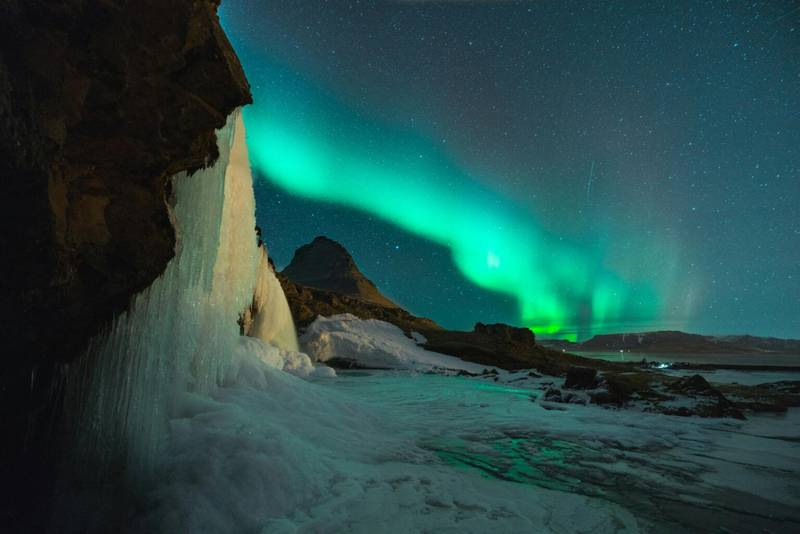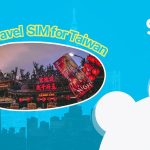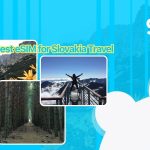Wondering how to chase the Northern Lights in Iceland? You’re not alone. Every year, thousands of travelers flock to this Arctic island hoping to catch a glimpse of the sky bursting into waves of green, purple, and red. And with good reason — Iceland offers some of the best conditions on Earth to witness this otherworldly display.
Thanks to its position directly beneath the Aurora Oval, Iceland is a prime destination for aurora seekers. Long, dark winter nights, low light pollution, and stunning natural backdrops like glaciers, black sand beaches, and frozen waterfalls create the perfect stage for the show.
It was back home that The Northern Lights cast these wondrous rainbows in the snow, and where Snugs used to play tag with the huge curtain of shining light that ran, even faster than the wind, across the vast snow-covered landscape.
Suzy Davies, Snugs The Snow Bear
In this guide, you’ll learn:
- What causes the Northern Lights (in simple terms)
- The best time and places to see them
- Tips to improve your chances
- What to bring and how to plan your trip
🌟 And here’s some great news: scientists say the lights will be stronger than usual around 2025, so now is the perfect time to go!

Image: Northern Lights dancing over an Icelandic landscape with mountains and a lake reflecting the green aurora.
Understanding the Aurora Borealis: What Makes the Northern Lights Dance?
Before you start planning your Icelandic aurora adventure, it’s worth learning what actually causes the Northern Lights—a little science goes a long way in helping you chase them successfully!
What Causes the Northern Lights?
The Aurora Borealis happens when charged particles from the sun hit gases in Earth’s upper atmosphere. This collision creates the glowing lights we see in the night sky.
Here’s a quick breakdown of the colors:
- Green: The most common color, caused by oxygen molecules about 100 km (60 miles) above Earth.
- Red: Rare and magical—these come from oxygen even higher up (300+ km).
- Purple & Blue: Caused by nitrogen, especially during stronger solar storms.
- Yellow & Pink: A mix of red and green lights blending in the sky.
Pretty amazing for a science experiment happening above your head, right?
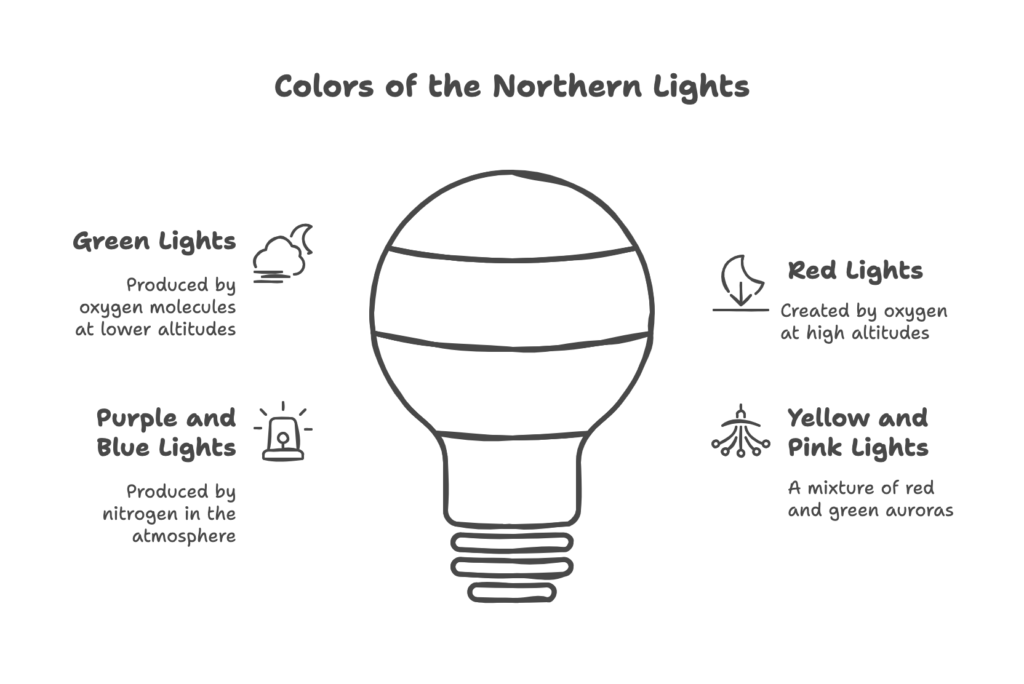
KP Index: Your Northern Lights Forecast Tool
If you want to chase the Northern Lights in Iceland, you need to know about the KP index—a number between 0 and 9 that shows how strong geomagnetic activity is:
- KP 2–3: Often enough to see lights in Iceland’s dark skies
- KP 4+: Brighter, more widespread displays (perfect for photography!)
- Use aurora forecast tools like Vedur.is (Icelandic Met Office) to check KP levels before heading out
Why 2025 is the Best Time: The Solar Maximum
The sun works in 11-year cycles, and we’re heading into a solar maximum in 2024–2025.
Why does that matter?
- More solar flares and activity = more auroras
- Brighter, more colorful skies across more nights
- Even lower KP levels could produce visible lights
In short: The upcoming solar peak means your chances of seeing epic Northern Lights in Iceland have never been better.
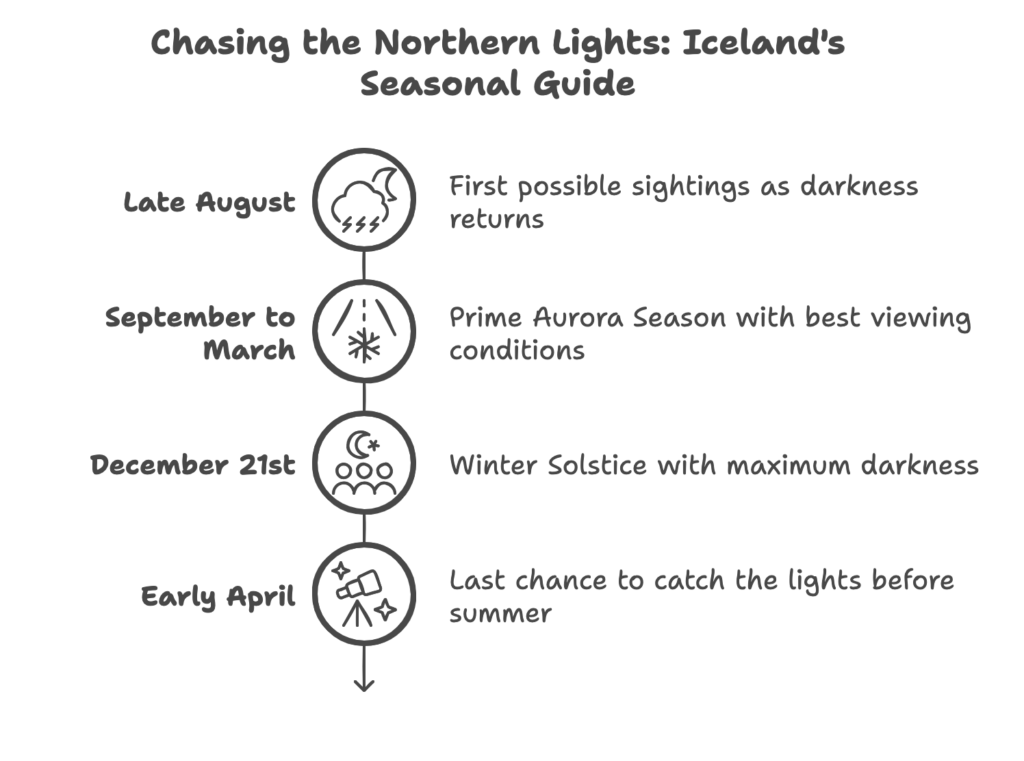
Best Time to See Northern Lights in Iceland: Seasonal Guide
When it comes to how to chase the Northern Lights in Iceland, timing is everything. While the aurora season stretches from late August to mid-April, some months offer much better conditions than others.
Prime Aurora Season (September to March)
This is the best time to visit Iceland for aurora hunting. Expect long nights, minimal light pollution, and high aurora activity:
- September & October: Milder weather, less snow, and the first magical lights of the season.
- November to February: Deep winter = up to 19 hours of darkness. Ideal for serious aurora chasers.
- March: A sweet spot. You get clear skies, longer days for sightseeing, and strong nighttime auroras.
Shoulder Season Views (Late August & Early April)
Even though these aren’t peak months, they can still surprise you:
- Late August: The return of darkness means early aurora sightings—just bring a warm jacket!
- Early April: The last aurora displays before the midnight sun takes over.
Winter Solstice: Maximum Darkness
If you’re planning a holiday trip, this is Iceland’s darkest and most magical time of year:
- Up to 20 hours of night
- Higher odds of seeing auroras
- A festive atmosphere with twinkling Christmas lights
- Perfect for combining with snowmobiling, ice caves, or soaking in hot springs
💡 Pro tip: The darkest skies don’t guarantee auroras—but they do give you the best chance. Always check the KP index and cloud cover forecasts before heading out!
🏕️ Looking for more nature + adventure? Here are the best national parks to visit for hiking and wildlife — from glaciers to grasslands.
Best Places to See the Northern Lights in Iceland
If you’re planning to chase the Northern Lights in Iceland, knowing where to go can make all the difference. While auroras can be seen across the country on clear nights, some spots offer better skies, less light pollution, and more scenic photo ops.
Reykjavik & Nearby: City-Based Aurora Hunting
Yes, you can see the Northern Lights in Reykjavik — especially if you escape the city lights just a little.
- Grótta Lighthouse: A classic aurora spot just 10 minutes from downtown. Minimal light, maximum magic.

- Öskjuhlíð Hill (near Perlan): Elevated, central, and surrounded by nature.
- Klambratún Park: Right in the city center, perfect if you’re short on time.
- Northern Lights Boat Tours: Cruise from Reykjavik’s Old Harbor for a water-based aurora experience.
Thingvellir National Park: Dark Skies & Dramatic Scenery
Just 45 minutes from Reykjavik, this UNESCO World Heritage site checks all the boxes:
- Low light pollution
- Gorgeous lake and lava landscapes
- Part of the Golden Circle, so easy to combine with daytime sightseeing

Image: Thingvellir National Park
Southern Iceland: Nature + Northern Lights
Pair Iceland’s most iconic landmarks with night-time aurora displays:
- Vík: Watch the lights dance above black-sand beaches and basalt sea stacks.
- Jökulsárlón Glacier Lagoon: Capture auroras reflecting in floating icebergs.
- Skógafoss Waterfall: Snap the lights above this dramatic 60-meter cascade.
- Seljalandsfoss: Lit at night — it creates a surreal photo scene when the aurora hits.

Image: Seljalandsfoss Waterfall
💡 Pro tip: Use a rental car to escape cloud cover and city lights — the aurora is often just one valley away. Apps like Vedur.is and Aurora Forecast help track the best chances in real time.
Remote Aurora Hotspots: For the Serious Hunters
Want darker skies and fewer crowds? These regions offer the most dramatic views:
- Snæfellsnes Peninsula: Wild coastline + glacier backdrops = stunning aurora shots.
- Westfjords: Remote, rugged, and almost completely free of light pollution.
- Lake Mývatn (North): Geothermal landscapes, lava fields, and a high chance of lights.
- Akureyri & North Iceland: Higher latitude = stronger aurora activity, even at KP 2–3.
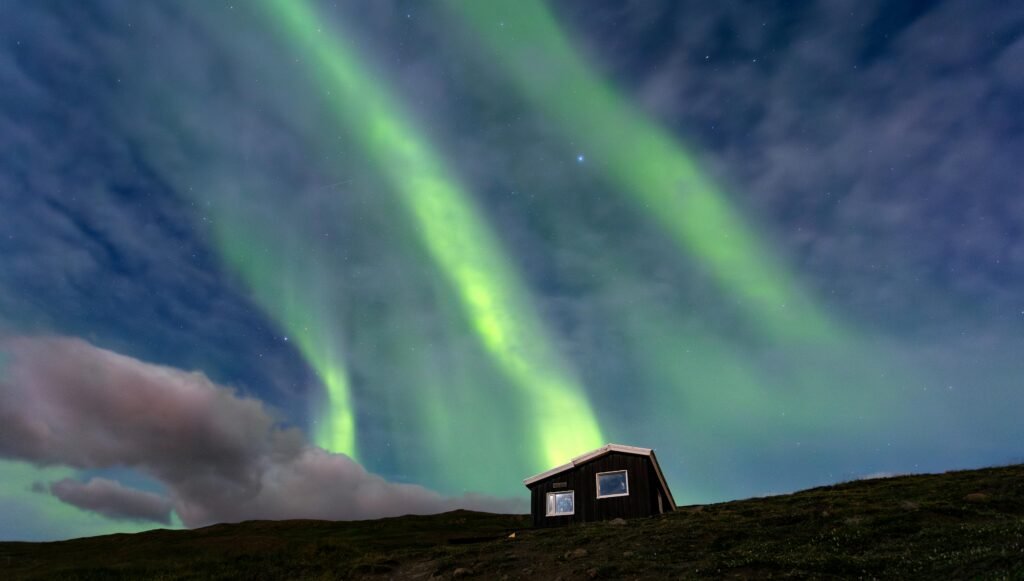
Image: Brown wooden house
Northern Lights Tours in Iceland: Best Ways to Experience the Aurora
When it comes to chasing the Northern Lights in Iceland, you’ve got two main options: join a guided tour or go the self-drive route. Each style has its perks depending on your travel preferences, budget, and adventure level.
Guided Northern Lights Tours (from Reykjavik)
If you’re staying in Reykjavik and want a stress-free experience, a tour is your best bet. These operators monitor aurora forecasts and take you to the best spots—often away from clouds and crowds.
Popular options include:
- Bus Tours: Budget-friendly, perfect for first-timers. Expert guides explain the science and monitor KP levels in real time.
- Super Jeep Tours: Small groups, off-road access, and better chances of escaping cloudy skies.
- Private Tours: Tailored for photographers, families, or couples. Maximum flexibility and one-on-one attention.
- Combo Experiences: Chase the lights and soak in hot springs, visit ice caves, or enjoy a traditional Icelandic dinner.
Why choose a tour?
- You’ll be with local experts who know where the skies are clearest.
- No winter driving stress—they handle the icy roads for you.
- Free rebooking if you don’t see the lights on your first night (offered by most operators).
- Get fascinating stories, science, and local legends from your guide.
Self-Drive Aurora Hunting: Freedom and Flexibility
For independent travelers, renting a car offers maximum flexibility:
- Create your own itinerary and timing
- Stay as long as you want at promising locations
- Combine with other sightseeing during daylight hours
- Access remote locations away from tour groups

Image: 4×4 vehicle parked under the Northern Lights on an Icelandic road
Northern Lights Boat Tours: Iceland from the Sea
Want to escape the land-based crowds? Try chasing the aurora by boat. These tours offer a peaceful, unique way to experience the lights dancing over the North Atlantic.
Why take a boat tour?
- Zero light pollution once you’re out on the water
- Reflections on the sea create a surreal viewing experience
- Includes extras like thermal overalls, hot drinks, and expert guides
- Fantastic photo ops without the worry of traffic or crowds
Most tours depart from Reykjavik’s Old Harbor and last around 2–3 hours.
Aurora-Friendly Hotels in Iceland
Many hotels in Iceland cater to Northern Lights travelers, offering features like wake-up calls, viewing observatories, and panoramic windows.
Here are some of the top picks:
- Hotel Rangá (South Iceland): Famous for its aurora wake-up service, on-site observatory, and prime countryside location.
- Northern Light Inn (near Blue Lagoon): Great mix of comfort, proximity to Reykjavik, and aurora alerts.
- Bubble Hotels: Sleep under the stars in transparent domes—in-bed aurora viewing at its most magical.
- ION Adventure Hotel: North-facing floor-to-ceiling windows and stunning highland views.
Pro tip: When booking, ask if they offer aurora alarms—many do, so you won’t miss a thing even if you’re asleep!
How to Photograph the Northern Lights in Iceland (Like a Pro)
Learning how to chase the Northern Lights in Iceland is only half the adventure — capturing them on camera is the other. Whether you’re using a DSLR, mirrorless, or even a smartphone, the right setup and techniques can turn a fleeting glow into an unforgettable photo.
Essential Aurora Photography Gear
Before heading out into Iceland’s frosty night, prep your kit with the right tools:
- DSLR or Mirrorless Camera: With full manual mode controls
- Wide-Angle Lens: Fast aperture recommended (f/2.8 or wider)
- Sturdy Tripod: A must to avoid blur during long exposures
- Remote Shutter Release or use your camera’s self-timer
- Spare Batteries: Cold kills battery life fast—bring at least 2–3
- Large Memory Cards: You’ll be shooting in RAW for best results
Best Camera Settings for Northern Lights Photography
Every aurora is different, so you’ll need to adjust, but here’s a solid starting point:
- Aperture: As wide as your lens allows (e.g., f/2.8)
- Shutter Speed: Between 5–15 seconds (shorter for fast-moving lights)
- ISO: Start at 1600, adjust based on light intensity
- Focus: Manual focus, set to infinity (∞) — use live view to fine-tune
- White Balance: Set between 3000K–4000K or try auto if unsure
Pro tip: Turn off long exposure noise reduction for faster shooting, and always shoot in RAW.
Composition Tips for Stunning Aurora Shots
The aurora is only half the picture — Iceland’s landscapes make the other half unforgettable.
- Include landmarks like waterfalls, glaciers, churches, or cabins
- Use reflections in still water (like Jökulsárlón or Lake Mývatn)
- Frame silhouettes of people for scale and storytelling
- Switch between portrait and landscape orientation
- Don’t be afraid to experiment with foreground interest and different focal lengths
Smartphone Aurora Photography: Yes, It’s Possible!
Modern smartphones (especially flagship models) can handle low-light conditions surprisingly well — with a little help.
- Use Night Mode or Pro Mode if available
- Stabilize your phone with a tripod or rest it on a solid surface
- Use a Bluetooth shutter remote or timer to prevent shakes
- Try dedicated apps like NightCap Camera (iOS) or Northern Lights Photo Taker
Afterward, edit your photos with tools like Lightroom Mobile to boost contrast and bring out detail—just keep it natural.
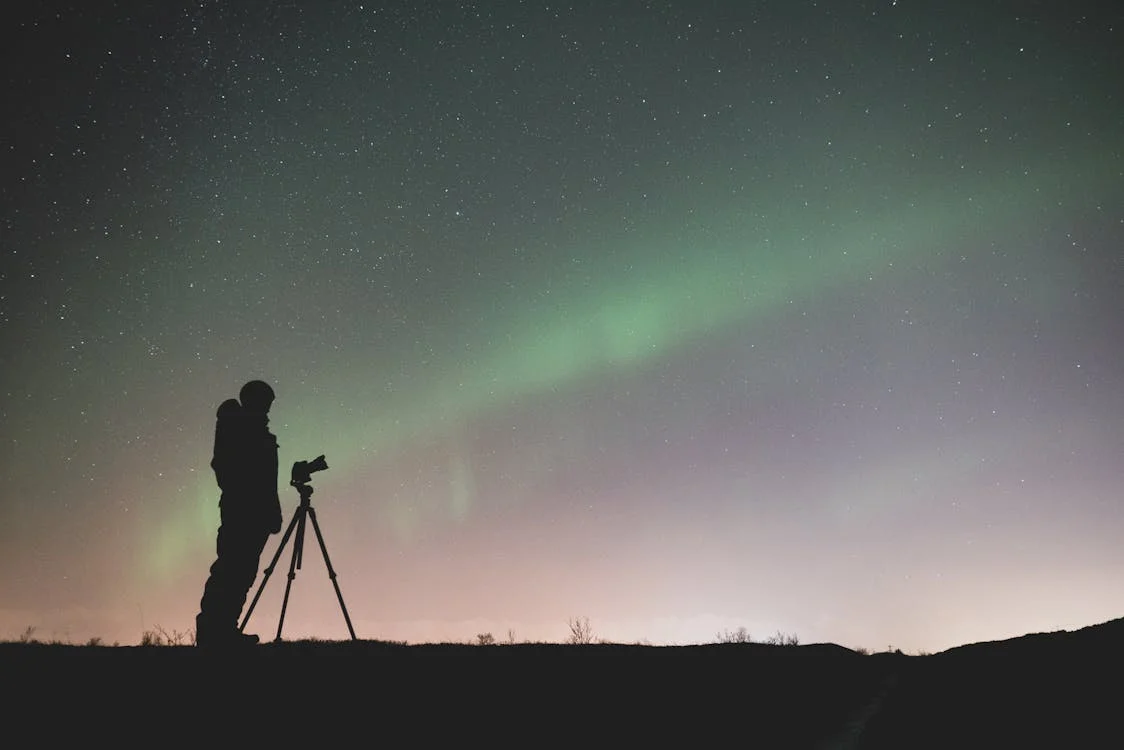
Image: Person photographing the Northern Lights with a camera on tripod
Staying Connected: Essential for Aurora Hunting
If you’re serious about chasing the Northern Lights in Iceland, staying connected isn’t optional — it’s essential. You’ll need live KP index updates, weather maps, GPS navigation, and in some cases, access to emergency services.
That’s where a reliable eSIM comes in.
Gohub eSIM: Stay Online, Stay Informed
With Gohub’s Iceland eSIM, you can stay online the moment your flight touches down — no physical SIM card, no local shop hassle.
Here’s why it’s a must-have for aurora chasers:
- Instant Activation: Connect as soon as you land
- Real-Time Aurora Forecasts: Check KP index, solar activity, and cloud cover on the go
- GPS & Maps: Navigate safely to remote viewing locations
- Share Instantly: Post your aurora shots live to friends or followers
- Emergency Safety: Stay connected even in rural or remote areas
🎒 Pro tip: Activate your Gohub eSIM before your trip so you’re connected the moment you arrive in Iceland — no SIM swap required.
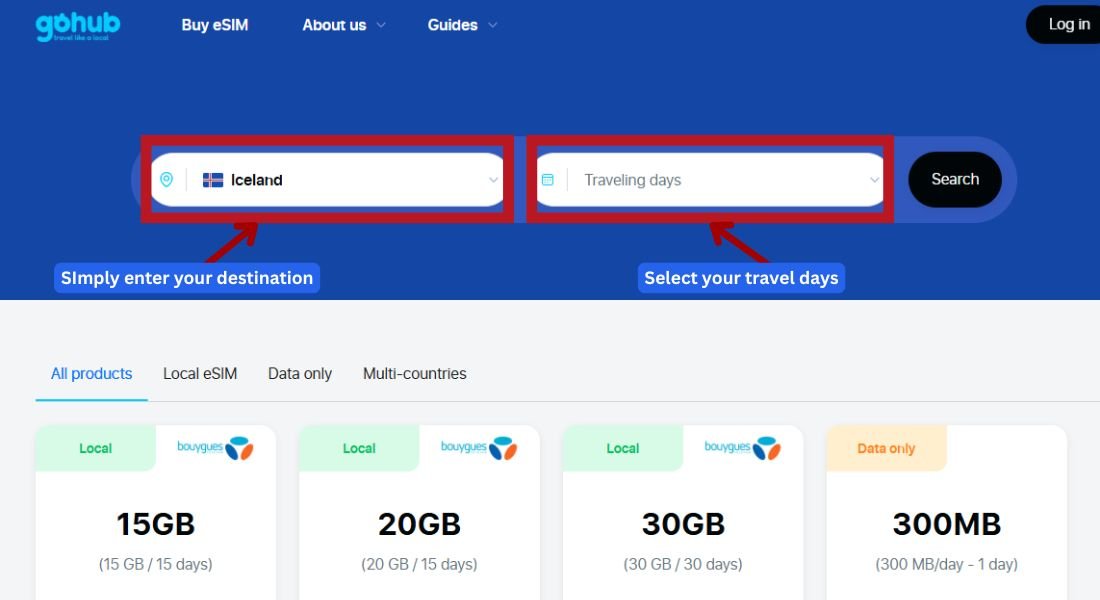
Image: Screenshot of the GoHub eSIM webpage, highlighting the destination input field with “Iceland” selected, illustrating how users can easily search for eSIM data plans.
👉 Explore GoHub’s Iceland eSIM plans now
Must-Have Apps for Aurora Forecasting & Navigation
Before you head into the Icelandic night, download these helpful tools:
- My Aurora Forecast: KP index, real-time alerts, viewing probability, and location tracking
- Veður (Icelandic Met Office): Reliable cloud cover and aurora visibility forecasts
- Photo Pills: Plan your camera shots and track celestial movements
- Iceland Road Guide: Up-to-date info on road closures, icy conditions, and safe routes
- 112 Iceland App: Share your GPS location instantly with emergency services if needed
Practical Tips for a Successful Aurora Hunt
Knowing where and when to go is just the start. To truly enjoy your aurora adventure in Iceland, you’ll need to be prepared for changing weather, long nights, and the unpredictable nature of the Northern Lights.
Weather Matters: Clear Skies = Clear Views
Even if the aurora is strong, clouds will block your view. Staying flexible and keeping an eye on weather forecasts is key.
- Check real-time cloud cover maps at en.vedur.is
- Don’t be afraid to drive to another area—microclimates mean one spot may be cloudy, while 30 minutes away it’s clear
- Icelandic weather changes fast—always have a backup plan
- Avoid frustration by building extra nights into your trip to maximize your chances
What to Wear for Northern Lights Viewing
Standing outside for long stretches requires the right clothing. Icelandic nights in winter can be very cold.
Here’s how to dress for warmth and comfort:
- Base Layers: Thermal top and bottoms (preferably wool or synthetic, not cotton)
- Mid Layers: Insulating fleece or down jacket
- Outer Layer: Waterproof and windproof shell (jacket + pants)
- Accessories: Beanie, neck gaiter, gloves, and wool socks
- Footwear: Insulated boots with good grip
- Extras: Bring hand and foot warmers—your fingers will thank you when handling your camera
Mindset: Patience is the Real Secret
Aurora hunting is a game of waiting, watching, and sometimes… hoping.
- The Northern Lights can appear out of nowhere, even after hours of nothing
- Give yourself multiple nights to improve your odds
- Let your eyes adjust to the darkness—it can take 15–20 minutes
- Bring hot drinks, snacks, and a thermos to stay cozy
- Most importantly: enjoy the moment. Even without the aurora, being under Iceland’s vast night sky is unforgettable.
🔦 Pro tip: Use a red flashlight or headlamp to preserve your night vision while adjusting camera settings or walking in the dark.
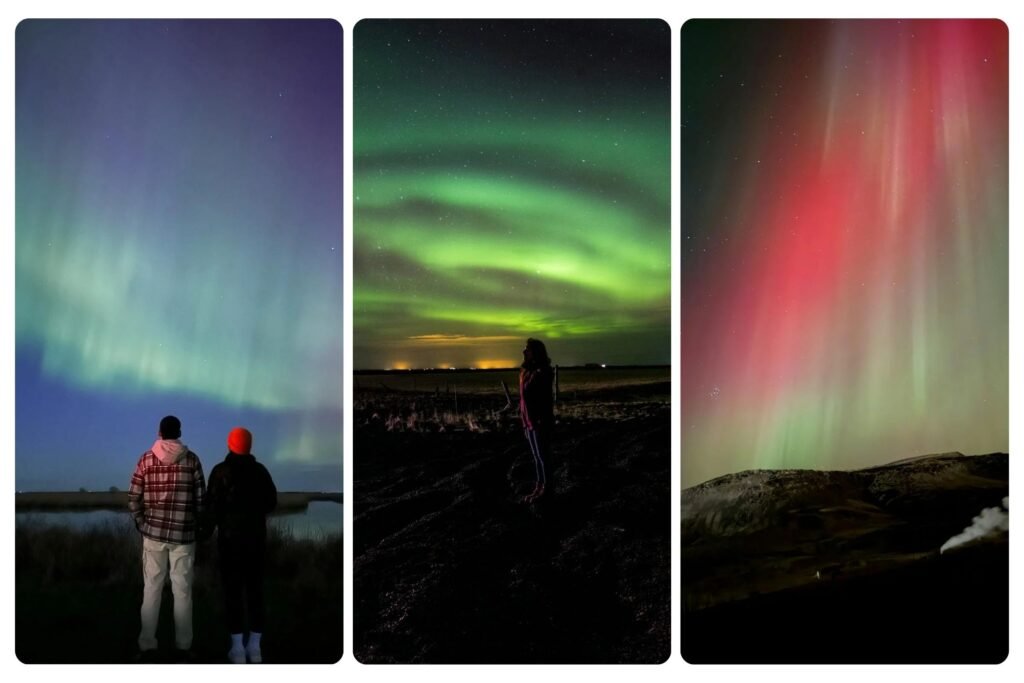
Image: Group of people waiting patiently for Northern Lights to appear in Iceland
What to Do While Waiting for the Northern Lights in Iceland
Aurora hunting often means long nights — but your days in Iceland can be just as magical. Whether you’re out exploring glaciers or soaking in hot springs, there’s plenty to experience while you wait for the skies to light up.
Daytime Adventures: Make the Most of the Sunlight
Iceland’s landscapes are just as impressive by day. Use your aurora downtime to discover some of the country’s top natural wonders:
- Golden Circle Tour: See the classic trio — Þingvellir National Park, the Geysir geothermal area, and Gullfoss waterfall.
- South Coast Road Trip: Visit Skógafoss, Seljalandsfoss, and the black sand beaches of Vík.
- Glacier Hiking: Strap on crampons and walk on ice with a guided tour.
- Ice Cave Tours (winter only): Step inside Iceland’s famous crystal-blue ice caves.
- Whale Watching (seasonal): Take a boat tour and look for humpbacks, orcas, and dolphins off the coast.
Relax & Recharge: Iceland’s Geothermal Wellness
Warm up and unwind before heading out for another night of sky-watching.
- Blue Lagoon: Iceland’s most iconic spa, just 20 minutes from Keflavík Airport.
- Sky Lagoon: A scenic thermal bath in Reykjavik with infinity-edge views over the Atlantic.
- Secret Lagoon: Less touristy, more natural — tucked away in the Golden Circle area.
- Local Pools: Almost every Icelandic town has a geothermal swimming pool with hot pots (and local gossip!).
Cultural Experiences & Local Flavor
Between light shows, dive into Icelandic culture and folklore.
- Aurora Legends & Folklore Tours: Discover the myths surrounding the Northern Lights, passed down through Icelandic generations.
- Museums: Check out the Aurora Reykjavik Museum for interactive exhibits and photo tips.
- Try Local Dishes: Warm up with lamb stew, fresh fish, or something adventurous like fermented shark.
- Craft Breweries: Sample Iceland’s growing craft beer scene at places like RVK Brewing Co. or Kaldi.
Northern Lights Tours in Iceland: What to Expect Before You Go
Choosing an organized tour is one of the easiest and most reliable ways to experience the Northern Lights in Iceland. If you’re short on time, unfamiliar with Iceland’s roads, or just want expert guidance — this is your best bet.
Here’s what you need to know before booking:
Types of Northern Lights Tours in Iceland
Whether you’re a first-time visitor or an aurora photography enthusiast, there’s a tour tailored to your style and budget.
- Standard Bus Tours
Affordable, beginner-friendly option (3–4 hours, ~9 PM departure). Great for solo travelers or budget-conscious groups. - Small Group Minibus Tours
8–15 people max. Offers more personal attention and better chances of venturing off the beaten path. - Super Jeep Tours
Premium, off-road adventure in rugged Icelandic terrain. Small groups (6–8 people) and deeper access to remote spots. - Photography-Focused Tours
Led by professional photographers who help with camera settings, compositions, and location scouting. - Multi-Day Northern Lights Packages
Combine aurora chasing with Icelandic sightseeing — think waterfalls, ice caves, and glacier lagoons, all in one trip.
What’s Typically Included in Aurora Tours?
Most Northern Lights tours from Reykjavik or other towns include the essentials (and a few cozy extras):
- Round-trip transportation to and from your hotel or pickup point
- Expert local guides who track KP index and cloud cover in real-time
- Hot chocolate or tea, plus light snacks
- Blankets or thermal overalls to stay warm under the stars
- Basic photography help for those without professional gear
- Free rescheduling or a second attempt if the lights don’t show
💡 Pro tip: Always check if your tour operator offers a “try again for free” p
Booking Tips to Maximize Your Chances
Want to boost your odds of seeing the lights? Keep these tips in mind:
- Book early — especially in peak season (Dec–Feb)
- Schedule your tour early in your trip to allow rescheduling if weather cancels it
- Read reviews to see how operators handle no-show nights
- Choose smaller groups for a more immersive and less crowded experience
- Photography lover? Book a specialized photo tour — it’s worth the extra cost
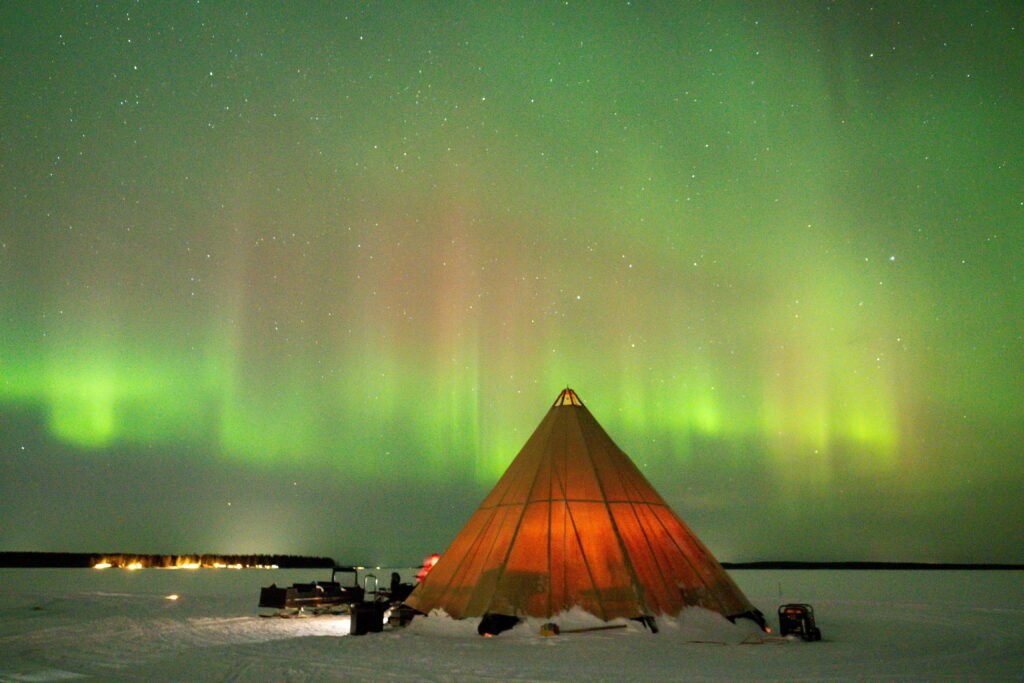
Image: Northern Lights tour group with guide pointing at aurora display
Planning Your Iceland Northern Lights Trip: Practical Information
Seeing the Northern Lights in Iceland is a dream for many — and with the right preparation, it’s totally doable. Here’s everything you need to plan a smooth, unforgettable trip under the Arctic sky.
Getting to Iceland: Your Aurora Adventure Starts Here
Most travelers fly into Keflavík International Airport (KEF), Iceland’s main gateway.
- Direct Flights: Available from major cities across Europe and North America
- Recommended Airlines:
- Icelandair – known for great service and flexible packages
- PLAY Airlines – budget-friendly with decent onboard comfort
- Flight Times:
- ~3–5 hours from Europe
- ~5–7 hours from the US East Coast
- Airport Transfers:
- FlyBus: Convenient shuttle service to Reykjavik (45–60 mins)
- Taxis or car rentals also available on-site
Where to Stay for the Best Aurora Viewing
Your accommodation can make or break your Northern Lights experience — choose wisely based on your travel style:
- Rural Hotels & Guesthouses
Far from city lights, often offer aurora wake-up calls so you don’t miss a thing. - Reykjavik Base
Ideal if you’re joining tours, want nightlife, and prefer central comforts. - Ring Road Lodging
Doing a self-drive trip? Book hotels and cabins along the Ring Road for flexibility and remote sky viewing. - Unique Stays
Try bubble hotels, glass igloos, or farmhouse conversions for a one-of-a-kind experience under the stars.
Budgeting for Your Northern Lights Trip
Iceland isn’t cheap — but with some planning, you can make the most of every dollar (or krona):
| Expense | Estimated Cost |
|---|---|
| Accommodation | $100–$300 per night |
| Car Rental (standard/4×4) | $50–$150 per day |
| Northern Lights Tours | $50–$200+ (type-dependent) |
| Meals at Restaurants | $15–$30 per meal |
| Self-Catering Groceries | ~$10/day |
| Popular Day Tours | $100–$300 (glaciers, whales, ice caves) |
| Connectivity (Gohub eSIM) | Affordable plans with no roaming fees |
🛰️ Pro tip: Skip roaming charges by using a Gohub eSIM for Iceland — stay connected from the moment you land.
Conclusion: Your Iceland Northern Lights Adventure Awaits
Learning how to chase the Northern Lights in Iceland is part science, part planning — and a whole lot of wonder. With this guide in hand, you’re ready to seek out one of nature’s most breathtaking performances under Arctic skies.
From pinpointing the best viewing spots to understanding the KP index, dressing right, and choosing between guided tours or self-drive adventures, you’re now equipped to make the most of your journey. And remember: patience and flexibility are just as important as your camera gear.
Even if the aurora doesn’t show on night one, Iceland’s dramatic landscapes, geothermal hot springs, and rich culture promise a trip worth taking. And when the lights do dance above the horizon? It’s a moment you’ll never forget.
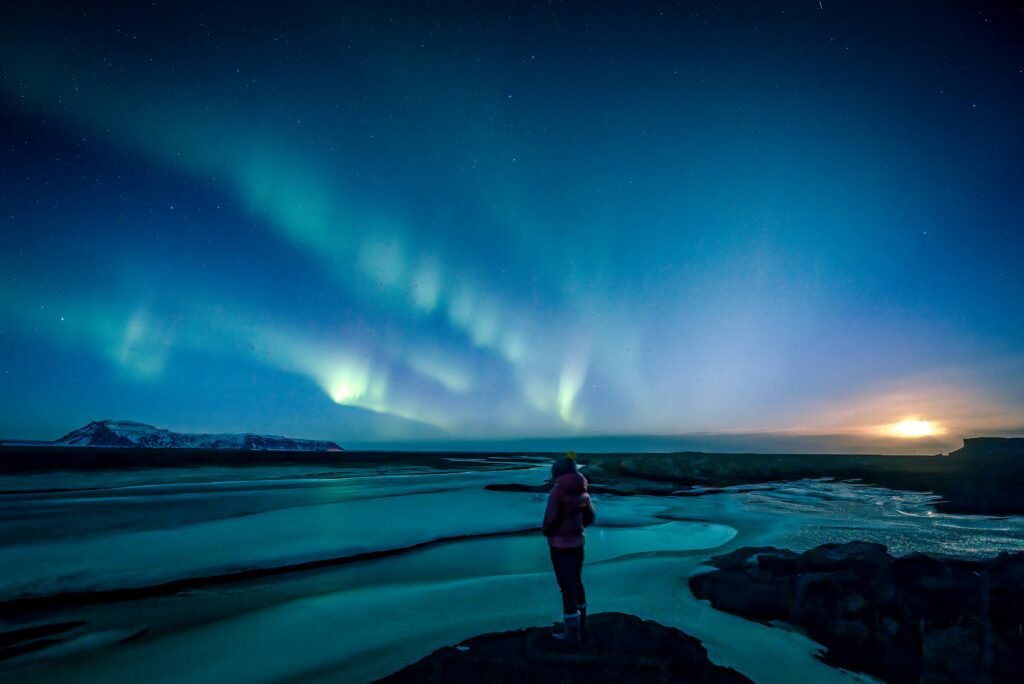
Image: Happy travelers celebrating after successfully viewing the Northern Lights in Iceland
Don’t Forget Your Gohub eSIM
Before you head off into the Icelandic wilderness, make sure you’re connected. With Gohub’s reliable eSIM for Iceland, you can:
- Stay safe and share your journey without roaming fees
- Check aurora forecasts and cloud maps in real time
- Navigate remote roads with ease
- Get instant internet access the moment you land
👉 Explore Gohub eSIM Plans for Iceland and travel smart, connected, and aurora-ready.


